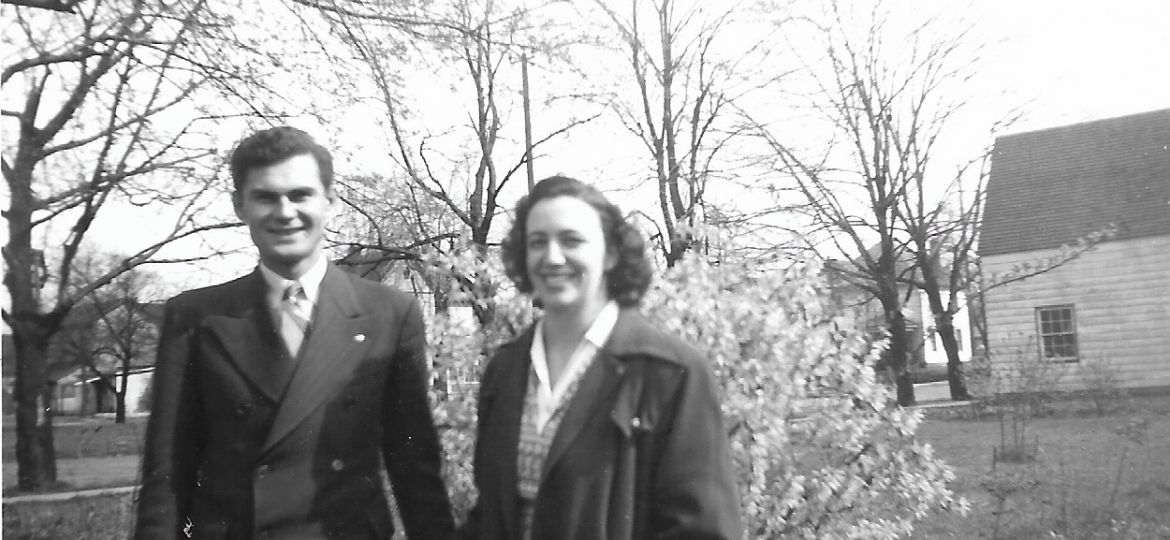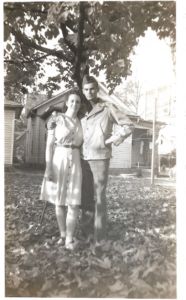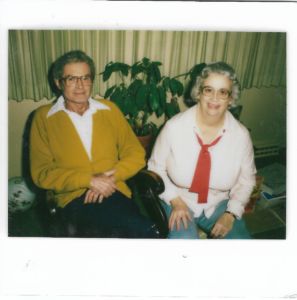
Indiana is widely known for its love affairs with corn, basketball, and the Indianapolis 500. But because we’re celebrating relationships all month, we decided to look deeper into Hoosier history to uncover some lesser-known romances. Whether you’re a hopeless romantic or have sworn off love, prepare to swoon over these two couples.
Tom and Mary Margaret Mee
 Tom and Mary Margaret ‘Margy’ Mee’s love story began in 1935, a year when the United States was in the grips of the Great Depression and on the verge of World War II. After attending grade school together, the two were reintroduced at 16 and 14 years old, respectively, at a Catholic Youth Organization (CYO) dance in Logansport, Indiana.
Tom and Mary Margaret ‘Margy’ Mee’s love story began in 1935, a year when the United States was in the grips of the Great Depression and on the verge of World War II. After attending grade school together, the two were reintroduced at 16 and 14 years old, respectively, at a Catholic Youth Organization (CYO) dance in Logansport, Indiana.
The two went on to be high school and college sweethearts and continued to date as they transitioned into the workforce. Then came December 7, 1941 and the attack on Pearl Harbor.
Margy was fresh out of college and working as a bookkeeper at a bank; Tom had worked at a factory and later enlisted in the Army Air Corps, which today is known as the Air Force. Feeling it was her duty to serve her country, Margy later enlisted as well. She joined the first class of the United States Naval Reserve, better known as the WAVES (Women Accepted for Volunteer Emergency Service).
In 1942, after Tom graduated boot camp and Margy was preparing to leave for the WAVES, the two said their goodbyes, unsure of when or if they’d see each other again. Tom’s service took him to the primitive islands of the South Pacific, New Guinea, and the Solomon Islands. As a woman, Margy wasn’t allowed to be near combat zones; rather, her enlistment kept her stateside: Seattle, New Orleans, Charleston, and St. Louis.
During their time apart, Margy and Tom maintained their relationship through handwritten letters. On better days, a photo from their travels was tucked inside the envelope.
“I think I told you in the other letter that I received the pictures you sent,” Tom wrote. “They are really swell. Every time I look at them I think how lucky I am.”
Today, stacks of Tom’s letters to Margy are dispersed between family members for safe keeping, while Margy’s letters to Tom were misplaced with time.
Geralyn Thompson, their youngest daughter, estimates that Tom wrote Margy just about every day they were apart, sharing details of his travels, writing declarations of love for her, and counting down the days until the war was over, whenever that would be.

“You’re the sweetest girl in this world, Margy, and I’d give anything to be with you now,” Tom wrote. “That’s nothing new, though, is it?”
On New Year’s Eve, Tom wrote, “Hope we have a date for next year, Margy. Only God knows whether we’ll be able to keep it, but it is something to look forward to. Golly, Margy, I’d like to see you.”
As any gentleman would do, Tom sent Margy flowers from time to time. He’d save enough money, then send it home to his mother who in return would send Margy a bouquet of flowers stateside.
“You know I want to marry you, Margy,” Tom wrote. “The sooner the better as far as I’m concerned. I’d be the proudest guy in the world.”
In the fall of 1945, after the war had just ended, Tom returned home to Logansport for a short break from the military. After not seeing Margy for three years, only communication via letters, he was prepared to propose to her.
“He went back and lost his nerve to ask her in person,” Thompson says
So, Tom returned overseas without a fiancée.
While there, Tom made good on his promise and proposed to Margy via none other than a handwritten letter on military stationary. After 11 years of dating, they married on July 4, 1946.
After the war, Tom took up a job at the First National Bank of Logansport and worked his way up to Senior Vice President and Investments Officer. Margy returned to bookkeeping, this time for a local insurance agency. They built a family together and had two children, Mary Lou and Geralyn.
“Their marriage taught me that marriage is a very special bond between two people that no matter what… even on the days you may not like each other, you always love each other and do nothing to hurt the other person,” Geralyn says. “No matter what you may face in a marriage you need to always be in it together”
 After 37 of marriage, Tom succumbed to emphysema in 1983. Margy passed from pneumonia and congestive heart failure in 2015.
After 37 of marriage, Tom succumbed to emphysema in 1983. Margy passed from pneumonia and congestive heart failure in 2015.
In those 32 years without Tom, Geralyn describes how Margy never dated or even took her wedding rings off.
“Her friends wanted her to take her wedding ring off, so she could date, and she said that she didn’t want to,” Geralyn says. “She said that she didn’t divorce my dad, he died. And she was never taking her ring off.”
David and Mahala Beem
In 1860, David Beem was 23 years old and fresh out of college at Indiana University. With his law degree in hand, David opened his own firm in his hometown of Spencer, Indiana. However, the Civil War had other plans for the new graduate.
On April 19, 1861, David enlisted as a First Sergeant in Company H, 14th Indiana Volunteer Regiment, and would later be made Captain in May 1862. As a notable Civil War veteran, David’s military service is heavily documented in Indiana history. As for his relationship with Mahala Joslin, the daughter of an Owen County physician, what we know about them is written in the love letters David wrote to Mahala from the frontlines at Antietam, Fredericksburg, Chancellorsville, Gettysburg and Cold Harbor, just to name a few.
It’s uncertain exactly how David and Mahala met, but what we do know is that they married on April 10, 1862 while David was on leave from the military.

In his letters, David often wrote to Mahala asking for advice or expressing the hardships caused by their separation. Most of them were signed with a swooning declaration of love. In one letter he wrote:
“I will say here often, I will be at home without doubt in less than a month from now, and this change in our company that is proposed will not break into our arrangements in the least. Now, I have tried to be fair and candid in telling you how the matter is, and I want you to write me immediately which you think I had better do. Were it not for you, I couldn’t tell in a moment which course I should take, but I desire you today which you would rather have me do. I wish I could see you. If it is needless for me to repeat what I have so often said, that you have the first place in my heart. Yours in love, David Beem.”
In another letter, David writes to Mahala during the holidays and expresses to her how his efforts to defend the country are not in vain. At one point he asks her to write him letters, “as soon, as often, and as long” as she could. He later describes his motivation to fight for and lead his country:
“…feeling as I do that I have so many whom I love, and who love me in return, I take more pleasure in contributing all I can to maintain for them good laws, free institutions, and a firm government that I could find anywhere else. In other world, if I loved no one, I would stay at home, but loving not only one, but others too, I am now in the field fighting for one of the best governments in the world.”
After three years of service, David left the military in June 1864. He and Mahala went on to have three children: Minnie Montrose, David Joslin, and Levi Amasa. Today, their letters remain a lasting example of love overcoming hardships, adversity, and war all for the love of country.
Samantha Kupiainen is a regular Indy Maven contributor.



